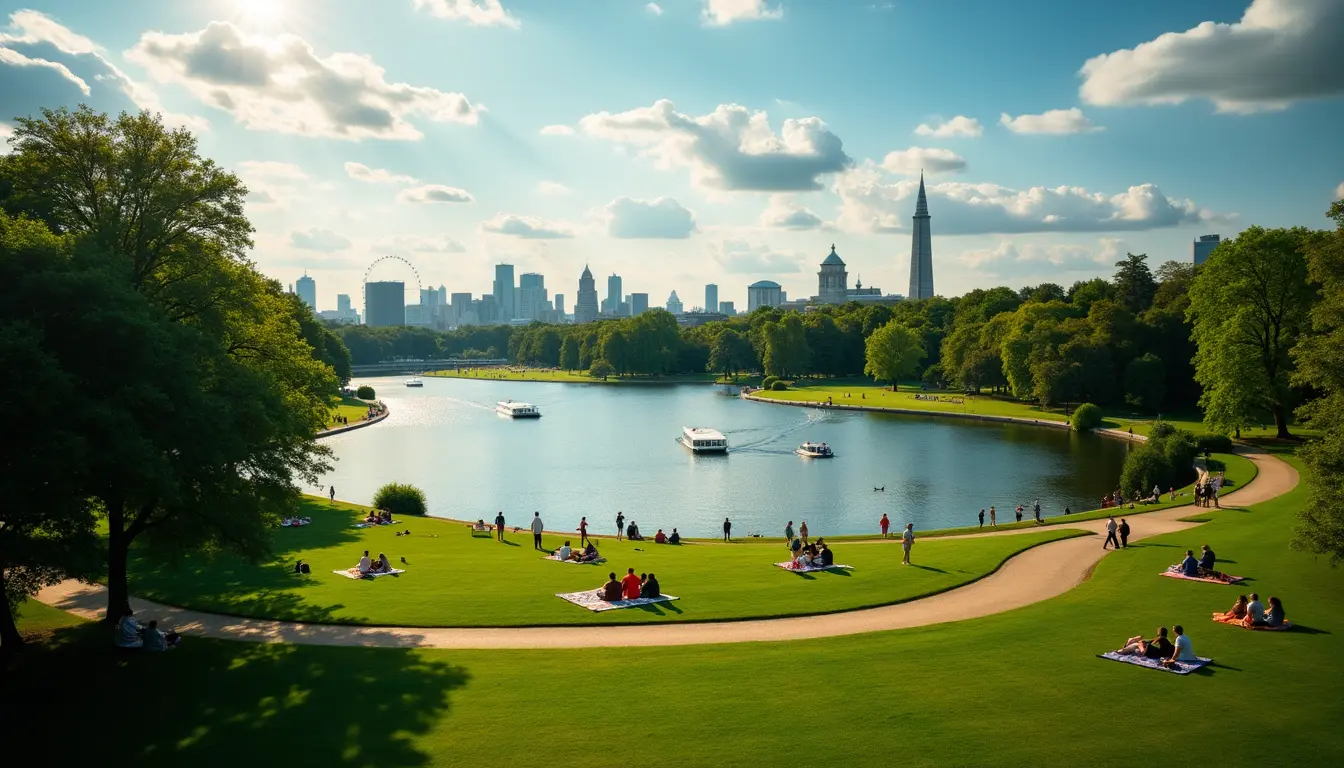Fancy escaping the city buzz? Let me tell you, London boasts a surprising number of amazing Parks in London, with over 3,000 green spaces dotted throughout the capital. Honestly, it amazes visitors and locals alike that the city dedicates nearly 40% of its area—that’s roughly 35,000 acres—to public parks and gardens.
London’s best Parks in London cater to absolutely every interest you can think of. You’ve got Richmond Park’s sprawling 2,300 acres where you can spot wild deer, while St James’s Park offers those magnificent royal views. Hyde Park has been welcoming visitors for almost 400 years, yet you can also find lesser-known spots like Hampstead Heath showing off spectacular city views from London’s highest points. The city’s beautiful parks range from the historic Royal Parks’ massive 4,882 acres to Victoria Park’s vibrant “People’s Park”. This incredible variety makes London truly special for families and nature lovers exploring the many Parks in London.
I’ve spent ages exploring these green sanctuaries myself, and it’s led me to create this piece about the 17 best parks that I think will genuinely revolutionise your London experience in 2025.
Hyde Park: London’s Huge Central Green Space
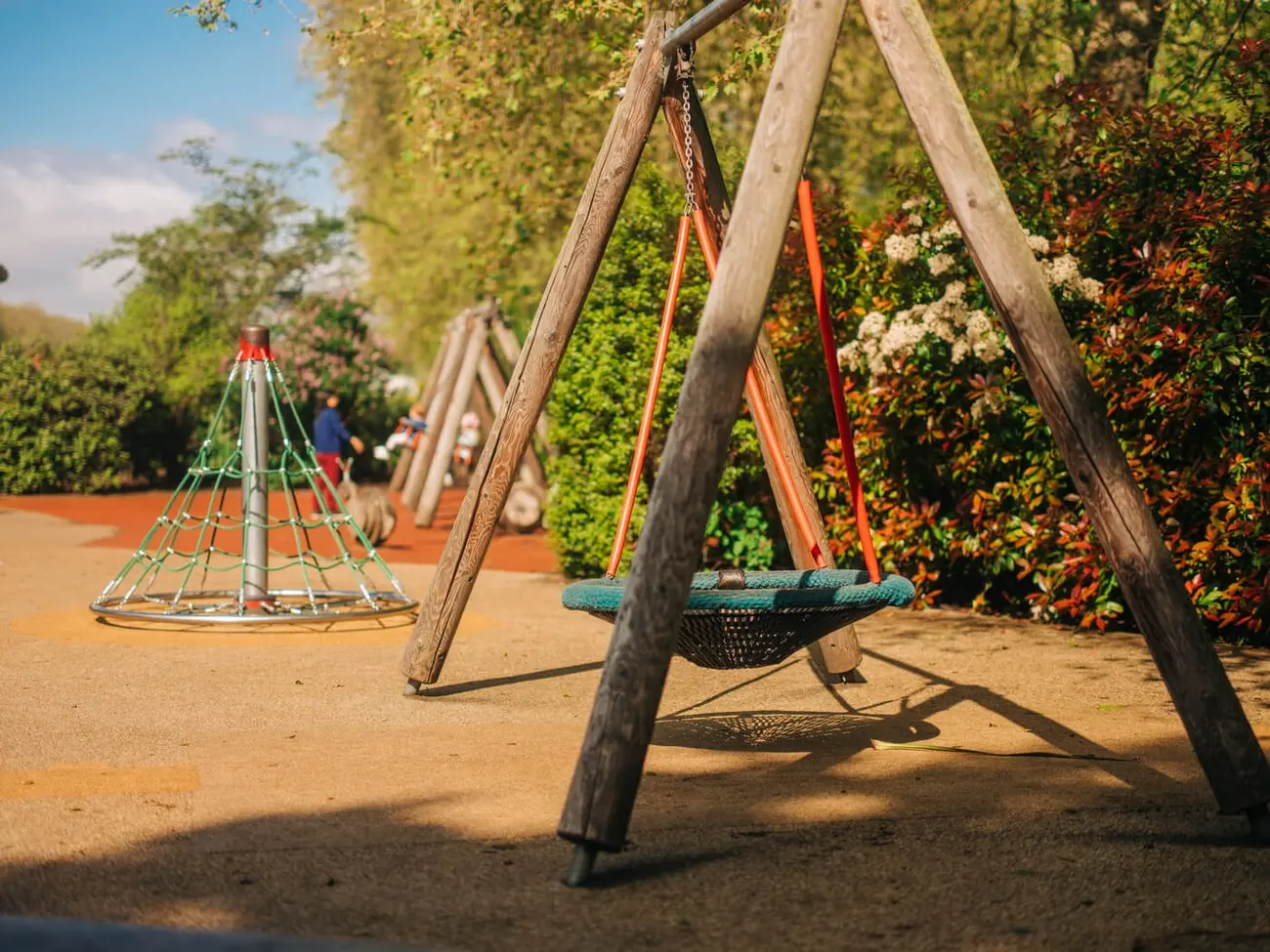
Image Source: The Royal Parks
Hyde Park is London’s largest central park, covering a massive 142 hectares (350 acres) – seriously, you could fit twelve Wembley Stadiums in this space with its three-mile perimeter. It’s one of those Parks in London that has delighted visitors since way back in 1637 and remains one of the city’s most cherished green spaces.
Hyde Park: Family Activities Galore
This park is just a fantastic playground for families with kids.
- Children can have an absolute blast at the Hyde Park Playground with its swings and climbing frames, making new friends along the way. Perfect if you’re looking for Fun Things to Do in London with Kids!
- There’s even The Senior Playground, which cleverly caters specifically to people over 50 who want to stay active.
- Keep an eye out for the free Discovery Days at the Hyde Park Learning Centre – these are brilliant for keeping kids busy during school breaks. They’ll love the drop-in sessions filled with stories, bug hunting, and nature crafts. It’s one of those fantastic Unusual Free Things to Do in London.
- Sports lovers should definitely check out Park Sports Hyde Park. It’s got tennis courts, padel facilities, a putting green, and spaces that accommodate lawn bowls and 5-a-side football.
Hyde Park: Boating and Lake Fun
The stunning Serpentine Lake really is the park’s crown jewel. This 40-acre recreational lake was created way back in 1730 and buzzes with water activities today.
- You can hire electric pedalos and rowing boats to see the park from a different angle between April and October.
- Each boat fits up to six people, making it great for family adventures on the water.
- Fancy a dip? The Serpentine Lido welcomes swimmers from May to September. Honestly, nothing beats a refreshing natural swim right in central London!
- And afterwards, The Serpentine Lido Café serves up hot chocolate that really hits the spot.
Hyde Park: Accessibility and Transport
The park’s location makes it super accessible by public transport, which is always a win.
- You’ll find several tube stations nearby: Hyde Park Corner and Knightsbridge on the Piccadilly Line, and Marble Arch on the Central Line.
- Loads of bus routes (like the 2, 6, 7, 9, 13, 14, 19, 22, and others) stop close to the park too.
- Cyclists are welcome and can use the marked cycleways throughout the park, with handy temporary bike racks often found at the Albert Gate entrance.
- Liberty Drives is a fantastic service helping visitors with mobility needs by providing free electric buggy rides around the park. Each buggy can take one wheelchair user and up to five companions, making exploring these beautiful Parks in London easier for everyone.
Regent’s Park: Elegance and Greenery
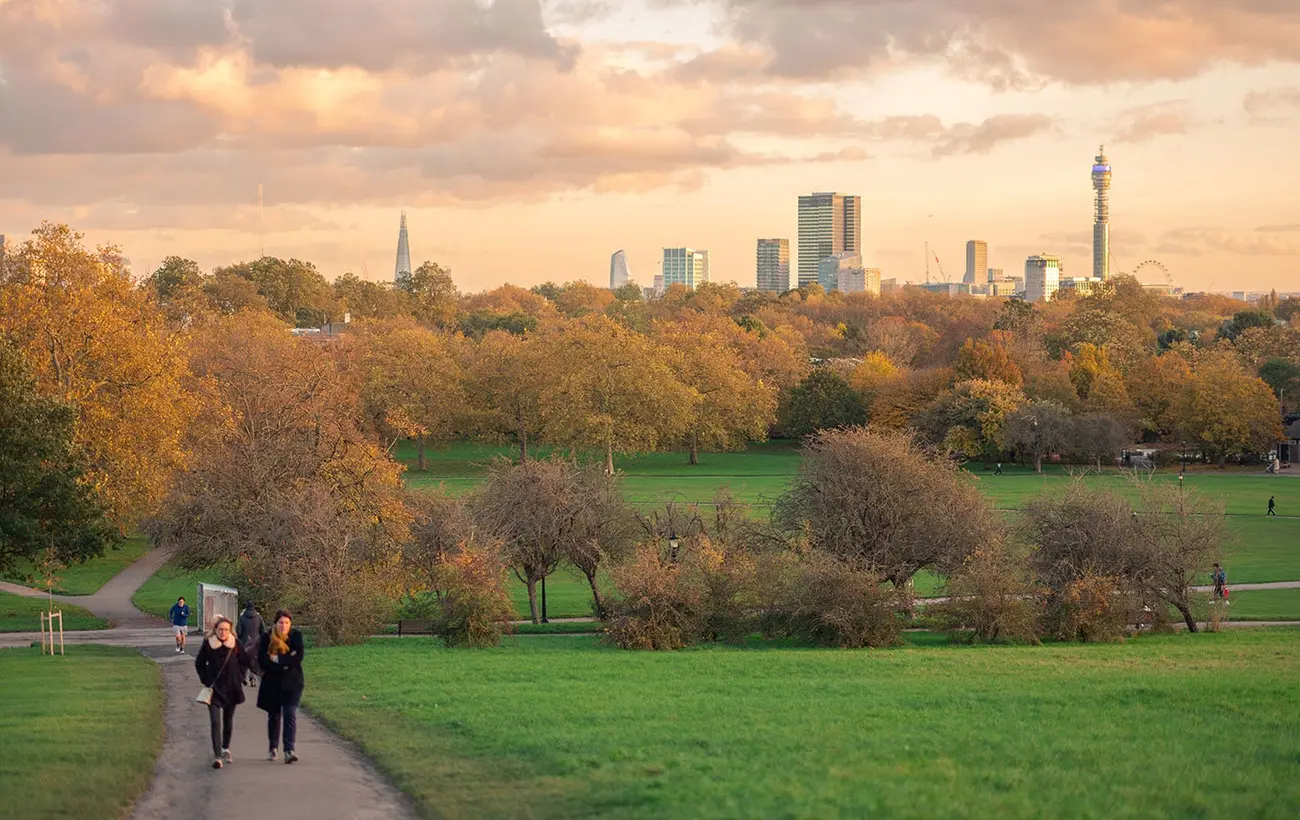
Image Source: The Royal Parks
Regent’s Park spreads across a lovely 410 acres in northwest central London. I always think this royal park stands out as one of the capital’s most refined green spaces. Its elegant mix of formal gardens and wide-open areas creates such a perfect balance between natural beauty and places to play or relax. It’s definitely one of the top Parks in London.
Regent’s Park: Playgrounds and the Famous Zoo
The park offers excellent playgrounds that kids absolutely adore.
- Younger children can enjoy climbing frames, swings, and sandpits at the Hanover Gate playground.
- The Gloucester Gate playground has more challenging equipment that older kids will really appreciate.
And of course, the world-famous ZSL London Zoo calls Regent’s Park home. As the oldest scientific zoo globally, it houses over 20,000 animals from 750 species and gives visitors loads of fun and learning opportunities. Some amazing exhibits include:
- The brilliant “Land of the Lions” exhibit, which brings India’s Gir National Park right here to London.
- Penguin Beach, where you can watch the daily feeding shows – always a crowd-pleaser.
- The Rainforest Life indoor tropical environment is fantastic too. Another great option for Fun Things to Do in London with Kids!
Regent’s Park: Rose Garden and Nature Wonders
For me, Queen Mary’s Gardens is the park’s absolute crown jewel. You’ll find London’s largest collection of roses tucked away in the Inner Circle, with around 12,000 roses from 400 different varieties. Trust me, the best time to see these stunning blooms is early June when they’re at their glorious peak.
The park’s wildlife is just as impressive as its flowers.
- Birds like herons and kingfishers thrive in the wetland area up north.
- The park’s well-maintained ecosystems provide shelter for more than 100 wild bird species and even a small group of hedgehogs. It’s a real haven within the city.
Regent’s Park: Perfect Picnic Areas
The park has become one of London’s favourite picnic spots, and it’s easy to see why.
- The English Gardens near York Bridge create cosy spots amongst ornamental shrubs and lovely seasonal flowers.
- Primrose Hill, which is technically part of Regent’s Park, lets you enjoy simply amazing views of London’s skyline – it’s magical as the sun sets over the city.
- Sports enthusiasts can enjoy their picnics near The Hub – a community sports centre with cricket pitches, football fields, and tennis courts.
- The lake also offers boat rides, giving you a peaceful way to see these glorious Parks in London from the water.
Kensington Gardens: Royal History and Peter Pan Magic
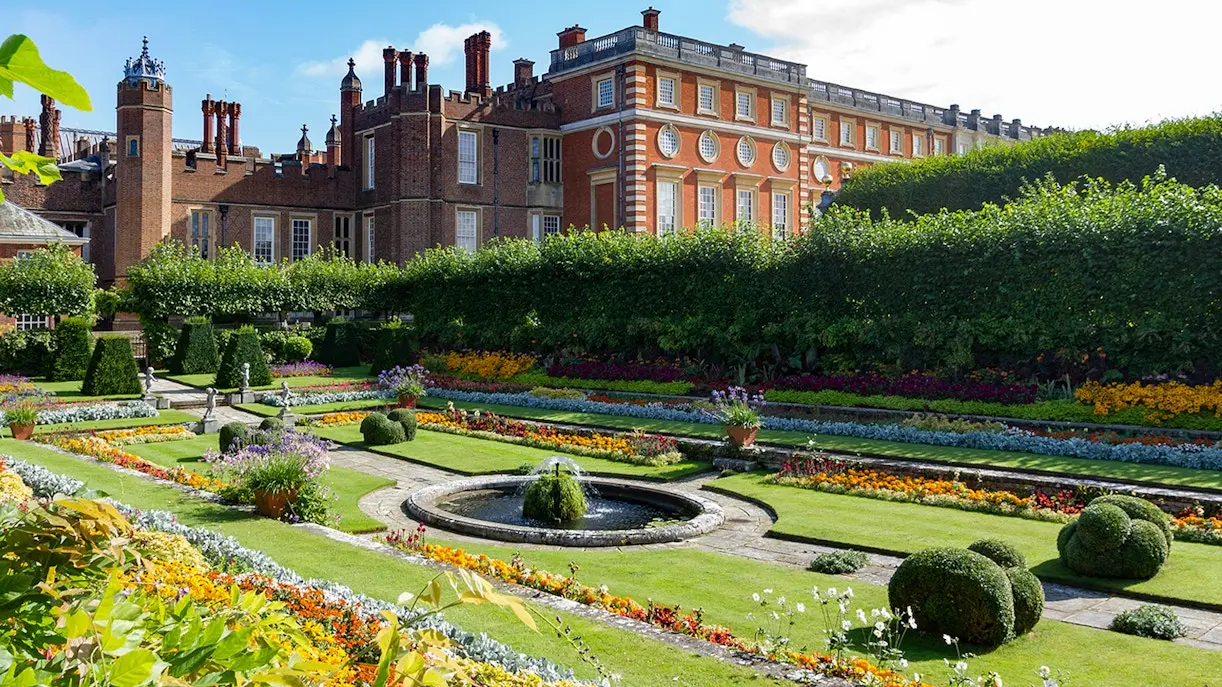
Image Source: London Tickets
Kensington Gardens covers a beautiful 265 acres, naturally connecting royal heritage with some fantastic family-friendly attractions. This space grew from a private royal garden into one of London’s most cherished green spaces after it was separated from Hyde Park way back in 1689. It’s another one of those lovely Parks in London with a royal feel.
Kensington Gardens: Fun for Kids
The Diana Princess of Wales Memorial Playground is the park’s main family attraction, drawing over a million visitors each year! And honestly, it’s easy to see why.
- A magnificent wooden pirate ship sits right at its centre, surrounded by a sandy beach, fun sensory trails, and teepees.
- J.M. Barrie’s Peter Pan actually inspired these features, adding a touch of magic.
- Just remember, children under 12 need adult supervision, and I’ve seen visitors lining up as early as 10 am on sunny days, so get there early if you can! It’s a top spot for Fun Things to Do in London with Kids.
Kids also love hunting for the bronze Peter Pan statue, which J.M. Barrie himself commissioned back in 1912.
- This magical sculpture shows Peter surrounded by squirrels, rabbits, and fairies.
- The Elfin Oak adds to the enchantment too – it’s an ancient tree stump covered in intricate carvings of magical creatures, dating all the way from 1930. Finding these unique spots feels like discovering one of the 15 Unusual Free Things to Do in London.
Kensington Gardens: Historical Highlights
The park’s rich history really comes alive through its impressive monuments.
- You can’t miss the grand Albert Memorial in the southern area – Queen Victoria’s stunning gothic tribute to her husband, Prince Albert. He’s shown holding the catalogue of the 1851 Great Exhibition he helped organise. It’s near some great museums, making it easy to combine with a visit to the 15 Must-Visit Free Museums in London nearby.
- Other remarkable monuments include Queen Caroline’s Temple (with lovely views of the Long Water), the beautiful Italian Gardens (Prince Albert’s gift to Queen Victoria), and King William III’s elegant bronze statue near Kensington Palace’s south gate.
Kensington Gardens: Seasonal Beauty
I love how the park changes its look with each season.
- Spring brings cheerful daffodils and stunning pink and white displays from the cherry blossoms.
- Summer is perfect for families enjoying picnics under the huge, sprawling trees.
- Autumn colours the landscape in vibrant reds, oranges, and golds – it’s beautiful for a walk.
- Winter brings a peaceful atmosphere, perfect for quiet walks even on chilly days.
No matter when you visit, the park’s winding flower walks and the Italian Gardens with their lovely cascading fountains showcase nature’s changing beauty. It really is one of the most picturesque Parks in London.
St James’s Park: Pelicans and Palace Views
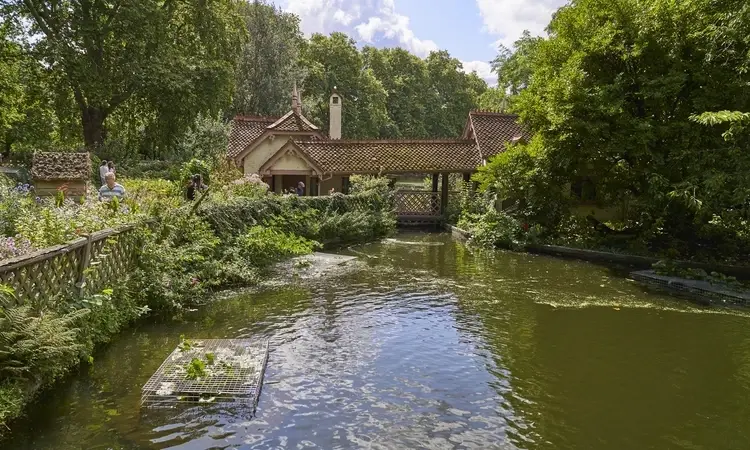
Image Source: The Royal Parks
St James’s Park is actually London’s oldest Royal Park, spanning 57 acres of beautiful grounds right in the heart of Westminster. This stunning green space sits conveniently between Buckingham Palace and Horse Guards Parade and offers some of the capital’s most breathtaking views. It’s one of the most iconic Parks in London.
St James’s Park: Wildlife and Famous Pelicans
The park’s famous pelicans are a real highlight! They’ve made their home here since 1664 after King Charles II received the first ones as a gift from the Russian Ambassador.
- Today, six pelicans named Isla, Tiffany, Gargi, Sun, Moon, and Star carry on this amazing 350-year legacy.
- You can watch these magnificent birds, with their incredible 3-metre wingspans, during their daily feeding time at 2:30 PM near Duck Island Cottage. It’s quite a sight!
The park’s Lake is also teeming with diverse waterfowl.
- You’ll see elegant black swans from Australia gliding alongside colourful red-crested pochards and eye-catching mandarin ducks.
- If you’re sharp-eyed, you might spot hedgehogs and bats near the water’s edge, while owls sometimes hunt silently after dark.
St James’s Park: Unbeatable Royal Views
For absolutely stunning views, head to the Blue Bridge stretching across the lake. Many people (including me!) say it offers London’s finest viewpoint.
- Photographers can capture an amazing shot that includes Buckingham Palace, the London Eye, and Horse Guards Parade all in one spectacular frame. You won’t get views quite like this from many Rooftop Bars London, that’s for sure!
History buffs will love the park’s royal connections too.
- The Mall borders the northern edge and serves as the ceremonial path to Buckingham Palace where royal processions take place.
- The Horse Guards Parade hosts the famous Trooping the Colour ceremony every year at its eastern end.
St James’s Park: Family-Friendly Cafes
Feeling peckish? St James’s Café welcomes families with its lovely lakeside location and beautiful views.
- This modern pavilion features indoor and outdoor seating where you can enjoy breakfast, lunch, or maybe even an alternative to a formal Best London Afternoon Tea while watching the wildlife.
- The Duck Island Cottage kiosk sells sandwiches, snacks, and ice creams for quick bites on the go.
- During summer, several mobile food vendors often pop up throughout the park, selling everything from classic British ice cream to speciality coffee.
Greenwich Park: Prime Meridian and Panoramic Vistas
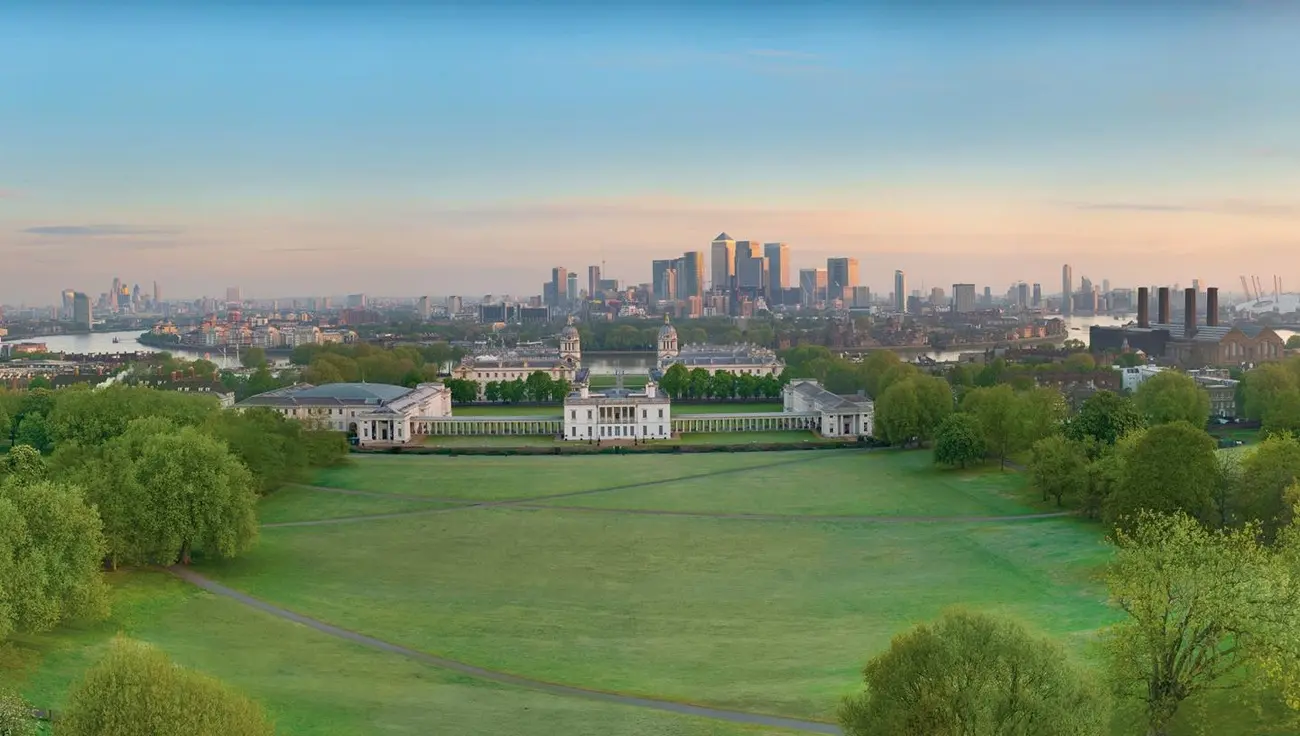
Image Source: Royal Museums Greenwich
Greenwich Park covers 183 acres of historic landscape and sits within the amazing UNESCO Maritime Greenwich World Heritage Site. This remarkable green space perfectly blends royal heritage, astronomical significance, and family entertainment all in one setting, making it one of the most unique Parks in London.
Greenwich Park: Stunning Panoramic Views
The park’s high ground offers some of London’s most stunning views. Honestly, prepare to be wowed!
- From the famous statue of General Wolfe, you get a spectacular panorama that sweeps across London’s skyline.
- This spot gives you an amazing view of the River Thames, the magnificent Old Royal Naval College buildings (now home to one of the 13 Best Universities in London), and stretches all the way to the skyscrapers of London Docklands.
- One Tree Hill is another fantastic vantage point for seeing Canary Wharf and central London, and it’s often a bit less crowded. These views have drawn artists and writers looking for inspiration for centuries!
Greenwich Park: Observatory and History
The Royal Observatory stands proudly at the park’s centre, commissioned by King Charles II way back in 1675.
- The famous Sir Christopher Wren designed this historic scientific building – Britain’s first purpose-built scientific institution!
- It was established to improve navigation and figure out longitude at sea, and the observatory was operational until 1947.
- Today, you can stand on the Prime Meridian Line (Longitude 0°) with one foot in the eastern hemisphere and the other in the western – it’s a special moment and a must-do photo opportunity! Nearby museums make this a great area to explore 15 Must-Visit Free Museums in London.
- Don’t miss the bright red Time Ball dropping at 1 pm daily – it’s kept this timekeeping tradition alive since 1833 without missing a single day. How cool is that?
Greenwich Park: Picnic and Play Zones
Families will find fantastic recreational spaces throughout the park.
- The maritime-themed playground near the Queen’s House is hugely popular, welcoming over 400,000 visitors each year.
- Recent upgrades have made this play area wonderfully accessible for children of all abilities. Kids love the basket swing, roundabout, and the sand and water play zones. It’s another brilliant choice for Fun Things to Do in London with Kids.
- The boating lake runs from Easter to October, perfect for summer fun on the water.
- Need refreshments? The charming octagonal Pavilion Café, an original 1906 building, serves drinks and snacks with beautiful Thames views from both its indoor and outdoor seating areas.
Hampstead Heath: Wild Swimming and Epic Views
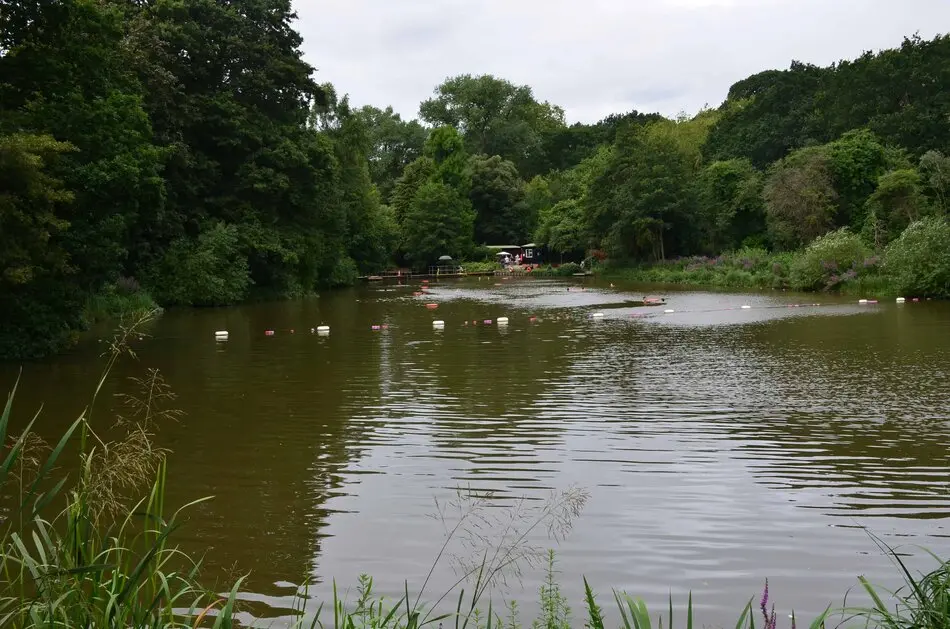
Image Source: Nomadic Niko
Covering a massive 320 hectares, Hampstead Heath really stands out as London’s wildest parkland. Think ancient woodland, rolling meadows, and honestly, some stunning elevated views. It’s one of those Parks in London that feels miles away from the city bustle.
The Heath has kept its natural character since the 1871 Hampstead Heath Act, which brilliantly made it mandatory to maintain “as far as may be, the natural aspect and state of the Heath”. I love that dedication to keeping it wild!
Hampstead Heath: Famous Swimming Ponds
Three historic swimming ponds, fed by the headwaters of the River Fleet, are one of the Heath’s biggest draws.
- Swimming enthusiasts can enjoy the Men’s Pond and Ladies’ Pond throughout the year, complete with lifeguard supervision.
- The Mixed Pond, over on the Hampstead side, welcomes swimmers only during the warmer months.
- These amazing natural swimming spots let you get close to local wildlife – you’ll often see herons, great-crested grebes, and sometimes even kingfishers visiting the waters. It’s a proper Unusual Free Thing to Do in London (though there’s a small charge for swimming now).
- Families looking for a more structured swim can head to the Heath’s huge 60-metre lido instead.
Hampstead Heath: Parliament Hill Views
Rising 98 metres (321 feet), Parliament Hill is one of London’s highest natural viewpoints. Trust me, the views are worth the climb!
- Visitors get protected panoramic views of the capital’s skyline from this peak.
- On a clear day, you can easily spot iconic landmarks like St Paul’s Cathedral, The Shard, and the Palace of Westminster, sitting about 6¼ miles south. For different city perspectives, check out some Rooftop Bars London, but this natural view is special.
- Parliament Hill apparently got its name during the Civil War when Parliamentary forces used it to defend London.
- Local stories even tell that Guy Fawkes planned to watch his Parliament plot unfold from this very hill! Spooky!
Hampstead Heath: Wonderful Nature Trails
The Heath’s rich ecosystems support an amazing diversity of wildlife. It’s one of the best Parks in London for nature lovers.
- Jackdaws, which rarely appear this close to central London, share the ancient woodlands with noisy ring-necked parakeets.
- If you’re sharp-eyed, you might catch treecreepers and nuthatches moving along the tree trunks.
- The Highgate ponds come alive in summer with azure blue dragonflies and common darter dragonflies zipping about.
- Families can enjoy fantastic walks on well-marked paths through woods and open fields, passing several picturesque ponds.
- Don’t miss the Hill Garden and Pergola – often called “some of London’s best-kept secrets”. This beautiful spot also provides a home to brown long-eared bats. It’s another gem for those looking for Unusual Free Things to Do in London (entry to the garden is free).
Victoria Park: The People’s Park with Buzzing Markets

Image Source: victoriaparkmarket.com
Victoria Park, lovingly nicknamed the “People’s Park,” has impressively bagged the Green Flag People’s Choice Award for 11 consecutive years! It really stands out as one of London’s most cherished green spaces. As London’s oldest public park (opening back in 1845), it now draws around 9 million visitors each year. That’s incredible!
Victoria Park: Vibrant Weekend Markets
Weekend social life often centres around Victoria Park’s bustling markets.
- Every Saturday from 11 am to 5 pm, the walkway between Gore Gate and Bonner Gate comes alive with some of London’s best street food sellers and drink vendors. You might find treats to rival the Best Breakfasts in London here!
- On Sundays, between 10 am and 4 pm, the same street (known as the Nightwalk) buzzes with over 60 traders.
- Visitors can find everything from seasonal produce, organic meat, and fresh fish to local bread and artisan products. It’s a great alternative to traditional Best Shopping in London if you love markets.
- Live jazz music often adds a lovely, relaxed atmosphere to the whole market experience.
Victoria Park: Fun Family Zones
The park’s play facilities are a massive draw for families, making it one of the best Parks in London for a day out.
- Kids absolutely love the V&A Playground near Mela Gate, with its swings, climbing equipment, sand play, and fun water pumps.
- Over on the east side, the Pools Playground features large slides and more climbing equipment for adventurous little ones.
- The splash pool runs daily from 11 am to 5 pm between the Spring Bank Holiday and the end of the summer holidays – perfect for cooling off!
- The park also provides tennis courts, a bowling green, cricket nets, football pitches, and even a skate park that welcomes skateboards, rollerblades, BMX bikes, and scooters. Loads to do for active families seeking Fun Things to Do in London with Kids.
Victoria Park: Lovely Canal-Side Walks
Victoria Park cleverly connects London’s green corridor, linking the River Thames at Limehouse through Regent’s Canal and Mile End Park.
- The canal-side paths offer beautiful views, especially lovely at sunset when the reflections of trees mix with the moored boats to create picture-perfect scenes.
- The park features several marked walking routes: the West Walk takes about an hour and showcases 27 different tree varieties, while the East Walk runs just over an hour past the boating lake and the deer enclosure.
- A full loop around the Avenue Perimeter stretches to about three miles – a good workout!
Battersea Park: Riverside Fun and Family Zoo
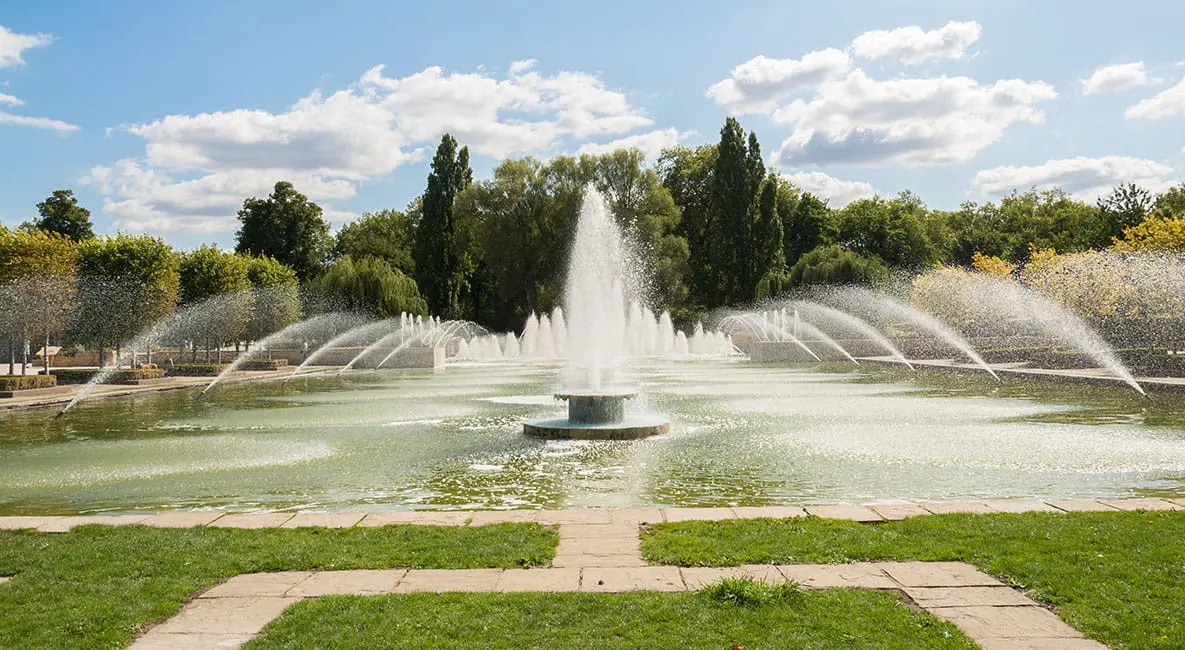
Image Source: Berkeley Group
Battersea Park captivates visitors with its huge 200-acre riverside setting, beautifully blending Victorian grandeur with modern recreational facilities. This cherished green space creates a perfect balance of natural beauty and family entertainment right on the Thames’ south bank. It’s one of the essential Parks in London to visit south of the river.
Battersea Park: Boating Lake Adventures
The peaceful boating lake is the park’s highlight for summer recreation.
- Bluebird Boats runs the lake operations during July and August, often extending the service through September weekends if the weather stays nice.
- Families can enjoy affordable boating, with adult tickets priced at £6 for half an hour or £8 for a full hour, and children’s tickets at £3/£4 respectively. Family packages offer good value at £13/£18.
- You can buy tickets and learn about the boating rules at the kiosk conveniently located near the Pear Tree Café before starting your water adventure.
Battersea Park: Charming Children’s Zoo
The family-run Battersea Park Children’s Zoo sits right at the heart of the park and is home to over 100 animals. It’s a perfect addition to your list of Fun Things to Do in London with Kids.
- Kids love meeting the diverse residents, including cheeky meerkats, Bolivian squirrel monkeys, emperor tamarins, lemurs, playful Asian short-clawed otters, and familiar farm animals.
- Daily keeper talks and feeding sessions are great for helping children learn about animal conservation.
- Adult tickets cost £10.95, children’s tickets are £8.95, and family tickets go for £35.50 (covering two adults and two children, or one adult and three children).
- The zoo welcomes visitors daily from 10:00 am until 5:30 pm in summer and closes slightly earlier at 4:30 pm in winter.
Battersea Park: Gorgeous Gardens and Cafes
Food lovers have several excellent spots to choose from throughout the park.
- The Pear Tree Café provides a stunning lakeside setting and stays open from 8:00 am to 9:00 pm daily (weather permitting). It’s a lovely spot, maybe even for a relaxed alternative to some Best London Afternoon Tea spots?
- Putt in the Park serves tasty wood-fired pizzas alongside snacks and coffee – perfect after a round of mini-golf!
- Quick bites are available at the Tea Terrace kiosk (between the fountains and zoo) or at the North Carriage Drive Snack Bar near Chelsea Bridge Gate car park.
- Ice cream vans often roam the park during warm weather, which is always a treat!
- Don’t miss the Old English Garden. Beautifully restored through a partnership between Jo Malone London and the gardening charity Thrive, it offers a peaceful haven filled with fragrant flowers all year round.
Bushy Park: Deer Herds and Woodland Gardens
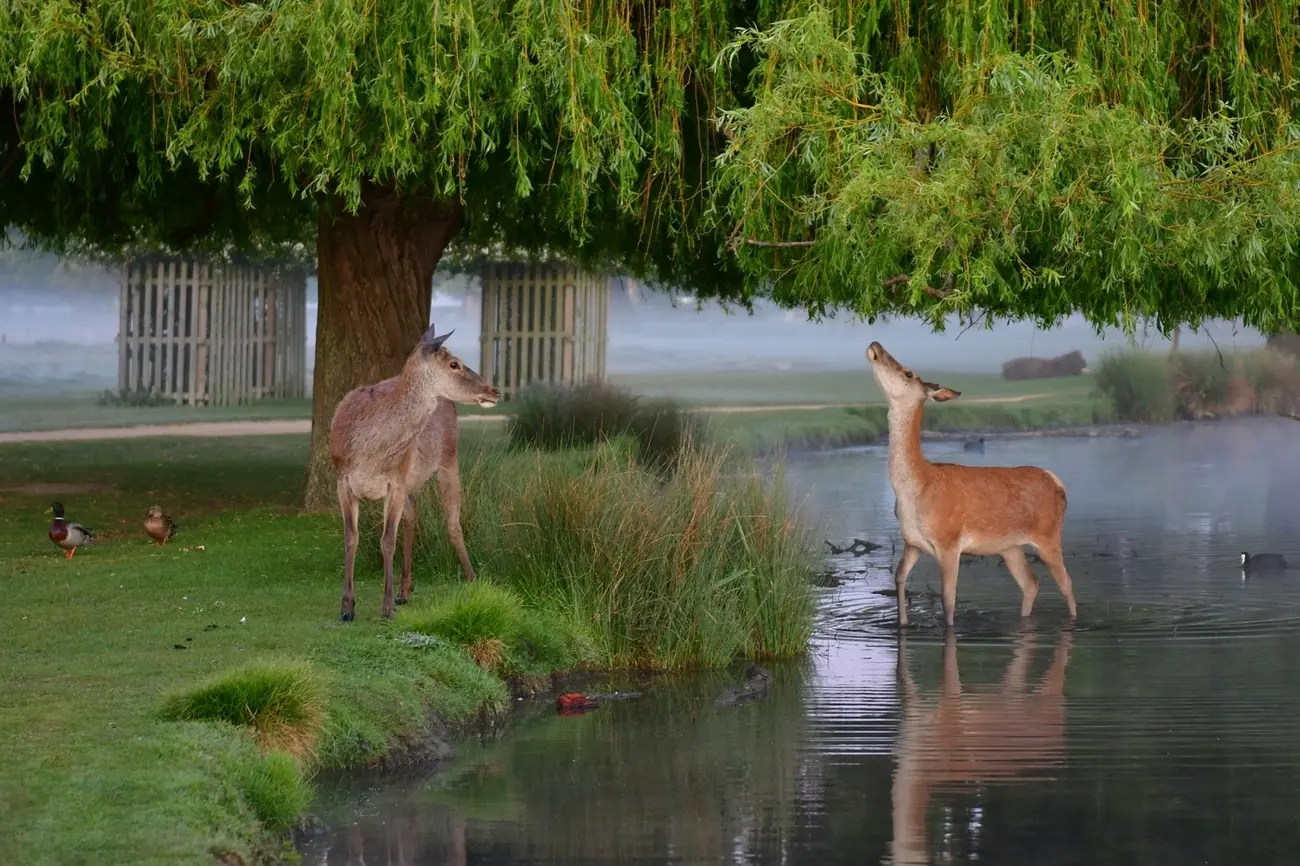
Image Source: The Royal Parks
Bushy Park stands proudly as London’s second largest Royal Park, spanning a massive 1,100 acres of ancient landscape. King Henry VIII actually turned this majestic space into his personal deer hunting ground way back in 1529! Today, the park delights visitors with its rolling grasslands, elegant water features, and peaceful woodland paths. It’s one of the grandest Parks in London.
Bushy Park: Deer Spotting Delights
You can spot over 320 free-roaming red and fallow deer roaming these grounds, just as their ancestors did more than 500 years ago. It’s quite something!
- Red deer, Britain’s largest native mammals, showcase their glossy coats proudly.
- Their cousins, the fallow deer, catch everyone’s eye with their distinctive spotted summer coats ranging from cream to darkish brown.
- Autumn brings the dramatic rutting season when stags compete for females by roaring and clashing antlers – it’s an incredible sight (and sound!).
- Safety first! Visitors must stay at least 50 metres away from these magnificent creatures, especially during the rut.
- If you’re patient, you might catch glimpses of stags with ferns tangled in their antlers or deer resting quietly among the dried ferns.
Bushy Park: Beautiful Woodland Gardens
The stunning 60-acre Waterhouse Woodland Gardens offers a peaceful escape with its vibrant plants, towering trees, and shimmering waterways.
- These gardens came to life in 1925 by joining two 19th-century plantations.
- I love this story: Park Superintendent Joseph Fisher later added his touch by marking out the winding pathways simply by dragging a stick through the woods!
- Visitors can discover peaceful spots like the King’s River Garden, Silver Birch Glade, and the surprisingly beautiful Bog Garden with its fascinating water-tolerant plants. It’s a bit of a hidden gem, like some spots in my guide to 15 Unusual Free Things to Do in London.
- The Pheasantry Café welcomes guests with refreshments in a lovely serene setting.
Bushy Park: Family Walking Trails
Historic paths wind through this ancient landscape, revealing traces of medieval farming and 17th-century water gardens.
- The Diana Fountain, a Grade I listed landmark, takes centre stage along Chestnut Avenue, which was designed by the famous Sir Christopher Wren.
- Kids love the newly renovated Bushy Park Playground near the Hampton Court entrance. It features fun turtle drums, cradle swings, and timber climbing frames – great for a family day out, similar to these 18 Fun Things to Do in London with Kids.
- The Longford River path adds another layer of history – this artificial canal, built by Charles I to supply Hampton Court Palace, now feeds the park’s ponds and streams.
- While walking these trails, nature enthusiasts can watch herons hunting for fish and listen to skylarks hovering above the breeze-swept meadows. It’s a fantastic example of the wildlife you can find in the Parks in London.
Richmond Park: London’s Largest Royal Park & Nature Reserve
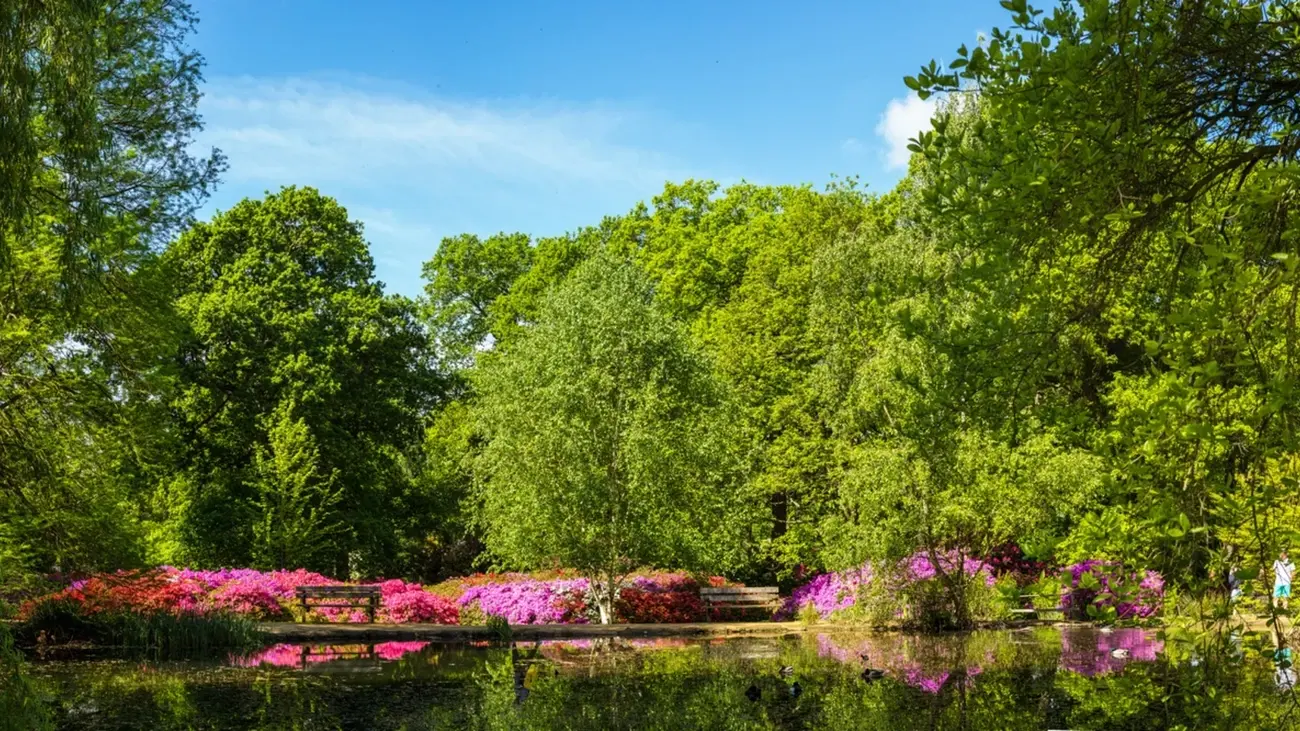
Image Source: The Royal Parks
Wow, Richmond Park is vast! At 2,500 acres, it stands proud as London’s largest Royal Park and the city’s biggest enclosed space. This former royal hunting ground has shaped the map of London for almost four centuries. Importantly, the park holds dual status as a National Nature Reserve and Site of Special Scientific Interest, making it incredibly special among the Parks in London.
Richmond Park: Wonderful Wildlife and Deer
Over 630 red and fallow deer have called the park home since 1637. These majestic animals truly shape the park’s unique character.
- Their grazing actually stops tree seedlings from growing, which helps preserve those sweeping open views and nationally important acid grassland habitats.
- Britain’s largest native land mammals, the red deer, show off their glossy red summer coats.
- Fallow deer catch the eye with spotted patterns ranging from cream to darkish brown.
- Autumn brings the dramatic rutting season. Males roar, bark, and clash antlers to win mates – it’s an incredible spectacle of nature!
- Remember to stay at least 50 metres away from these wild animals. I learned this is especially important during mating season (September-October) and birthing season (May-July) when males can become aggressive and protective mothers are defensive. They can weigh up to 200kg and run at speeds of 30mph, so give them space!
Richmond Park: The Stunning Isabella Plantation
Tucked inside the park is the Isabella Plantation – a stunning 40-acre woodland garden dating back to the 1830s. This botanical gem opened its gates to the public in 1953.
- The garden boasts impressive collections of rhododendrons, magnolias, camellias, and simply stunning evergreen azaleas.
- Top tip: These azaleas reach their peak bloom in late April and early May – it’s breathtaking!
- The garden proudly holds the National Plant Collection of Wilson 50 Kurume Azaleas, which originally came from Japan in the 1920s.
- Although the plantation looks carefully tended, it follows organic principles. This creates rich habitats supporting over 40 fungi species, more than 50 beetle species, and over 130 butterfly and moth species!
- Natural ponds, filled with water from the nearby Pen Ponds, create vital wildlife habitats and connect to the park’s larger water system. It’s a must-visit spot and feels like another of London’s wonderful Unusual Free Things to Do.
Richmond Park: Scenic Cycling Routes
The park’s varied terrain offers cyclists plenty of adventure options.
- The Tamsin Trail is a popular off-road loop stretching 7.35 miles (11.8km) around the park’s edge. This natural, somewhat rugged path winds through ancient woodlands, grassy clearings, and open heath – mountain bikes, hybrids, or gravel bikes work best here.
- Road cyclists often use the park’s roads for training, especially in the early mornings or evenings when traffic is quieter.
- Your ride rewards you with fantastic London skyline views. Head to King Henry’s Mound, the park’s highest point, for a protected view of St. Paul’s Cathedral over 10 miles away! It rivals some views from Rooftop Bars London.
- The landscape changes dramatically with the seasons, making every ride unique in this amazing Royal Park.
Holland Park: Kyoto Garden Serenity in Kensington
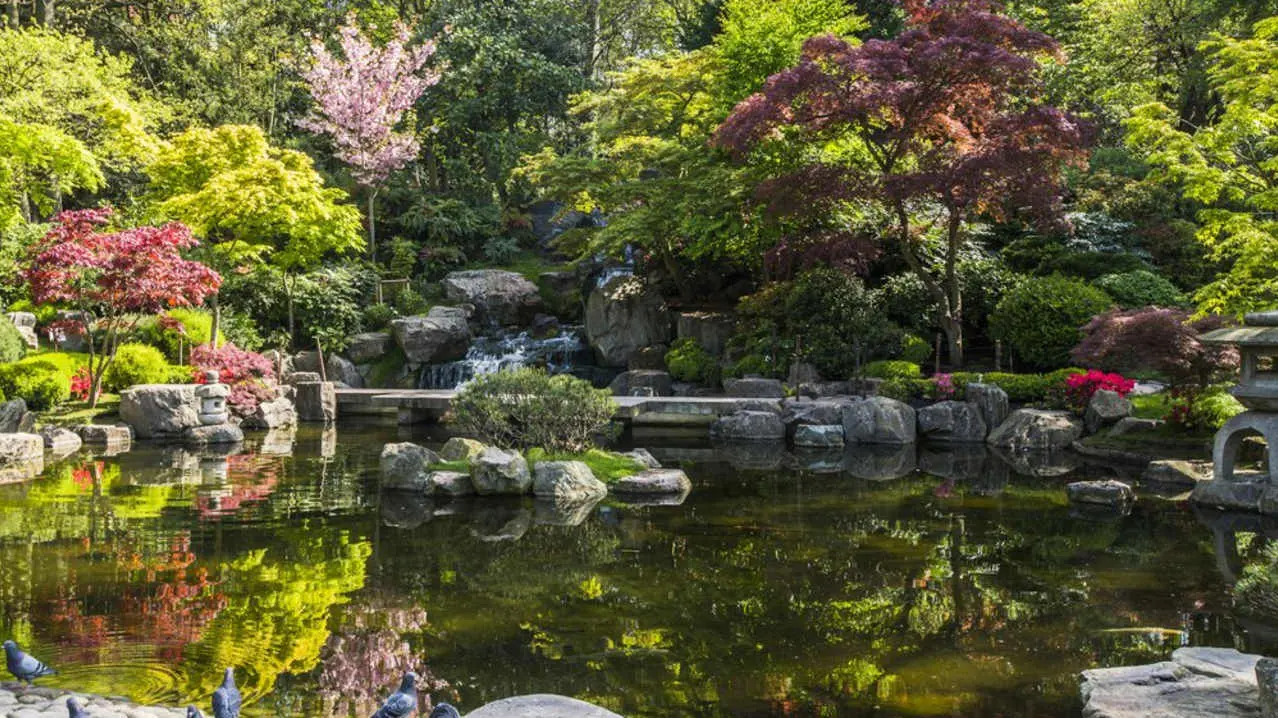
Image Source: Day Out With The Kids
Holland Park sits right in the heart of stylish Kensington and Chelsea. This 54-acre sanctuary beautifully combines peaceful woodland paths with formal gardens and great family-friendly features. It’s easily one of my favourite Parks in London.
This beautiful green space serves as a perfect retreat for tourists wanting to experience London’s greener side, and for locals seeking a welcome break from city life. It’s located in one of the Best Places to Live in London, near fantastic Best Shopping in London too!
Holland Park: Tranquil Kyoto Garden
My favourite part has to be the Kyoto Garden – it really stands out as Holland Park’s crown jewel.
- The Chamber of Commerce of Kyoto generously donated this space in 1991 to celebrate the Japan Festival held in London in 1992.
- Visitors will find a beautiful, tranquil mix of Japanese maple trees, a calming tiered waterfall, traditional stone lanterns, and a pond where colourful koi carp swim peacefully.
- This garden represents the strong friendship between Japan and the UK and creates such a peaceful atmosphere that you’ll completely forget you’re near busy city streets.
- Honestly, the garden looks stunning even on cloudy days and offers fantastic photo opportunities, especially if you arrive early before the crowds build up. It’s another Unusual Free Thing to Do in London.
Holland Park: Excellent Playgrounds
Kids will absolutely love Holland Park’s amazing play areas.
- The park actually has two different playgrounds – a special enclosed space designed for under-fives, and a brilliant adventure playground catering to 5-14 year olds.
- The adventure playground comes packed with climbing frames suitable for different ages, a fun sand and water play area, a mini trampoline, a large communal swing, and an exciting zip-wire.
- These play spaces sit conveniently near the ecology centre and give children the perfect spot to release some energy between meals or sightseeing trips. It’s ideal for families looking for Fun Things to Do in London with Kids.
Holland Park: Peaceful Woodland Walks
The wooded trails along one side of Holland Park offer nature lovers a favourite escape right within London. These paths create a wonderful sensory experience.
- You’ll hear birds singing overhead, spot squirrels darting through the undergrowth, and breathe in fresh earthy smells.
- Muddy paths covered with twigs and fallen buds split off in different directions, making exploration really fun.
- Sunlight filters through the branches, creating dancing shadows on the ground.
- This magical setting truly helps you forget you’re in one of the world’s busiest cities. It’s a refreshing contrast to the more formal Parks in London.
London Fields: Hackney’s Lido and Market Hub
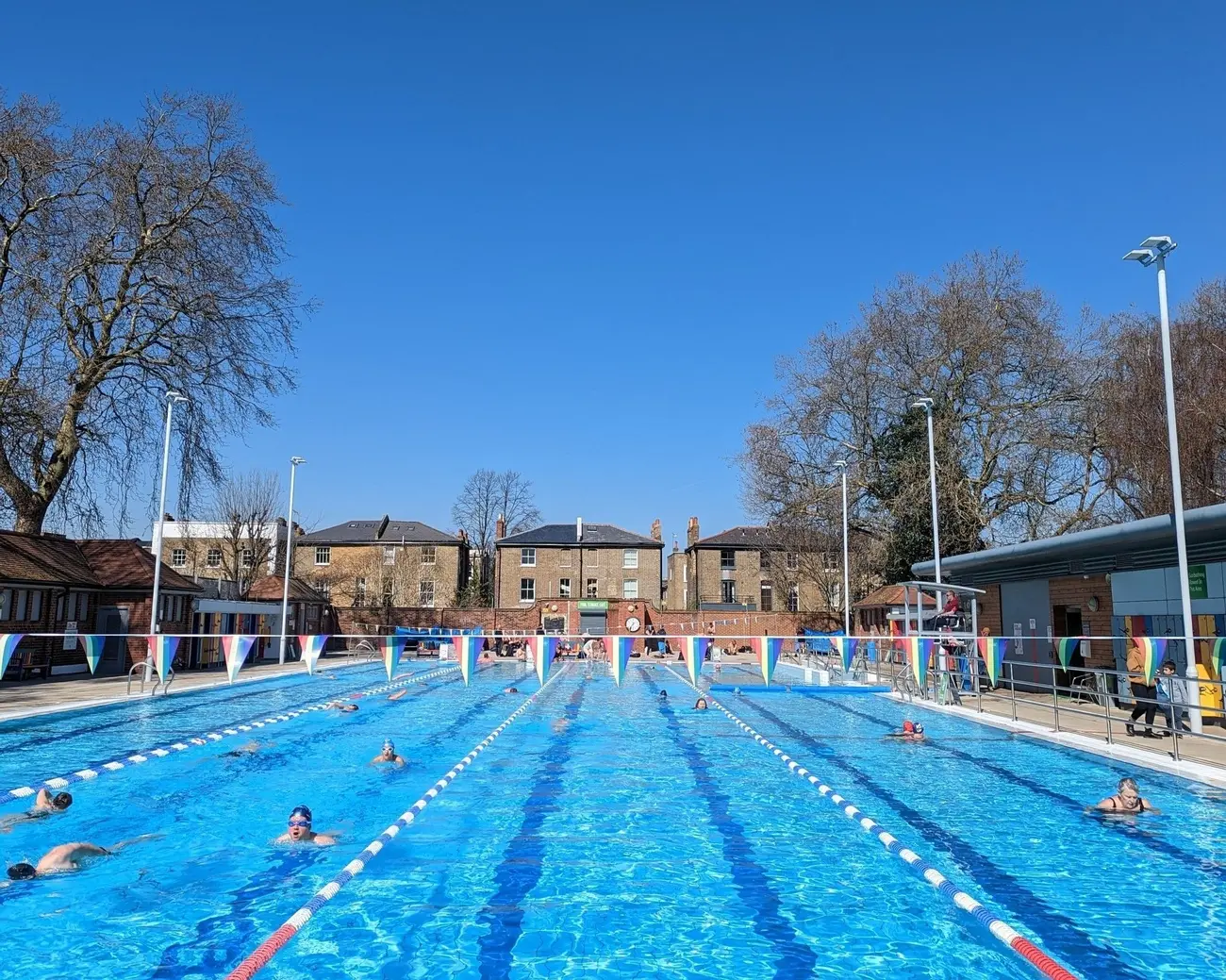
Image Source: East London Newsletter
London Fields stretches across a lively 31 acres over on the capital’s eastern side, in buzzing Hackney. I think this urban retreat perfectly balances great recreational facilities with natural beauty. It proudly holds the Green Flag award, marking it as one of the country’s best green spaces and a favourite among East London’s Parks in London.
London Fields: Lido Fun and Sports
The park’s 50m Olympic-size outdoor swimming pool is definitely its crown jewel.
- This beloved lido first opened its doors way back in 1932 but sadly had to close in 1988 due to funding cuts.
- But here’s the inspiring bit: the London Fields User Group campaigned tirelessly for 18 years, and their amazing efforts paid off when the pool finally reopened in 2006!
- Today, it welcomes over 340,000 visitors every year. What a comeback story!
- Swimmers can enjoy the pool all year round, with water temperatures kept at a surprisingly cosy 24-25 degrees Celsius.
- Evening sessions are possible thanks to floodlighting, making this one of London’s rare all-season outdoor swimming spots – a proper Unusual Free Thing to Do in London!
- The pool offers daily lane swimming, lessons for all abilities, and even one-to-one coaching.
- You’ll also find a café and a spacious sundeck, perfect for relaxing after your swim.
- Importantly, the facility caters to everyone with ramp access, a pool hoist for wheelchair users, and level access throughout.
London Fields: Vibrant Picnic Culture
Summer brings a special kind of magic to London Fields.
- On Saturdays, the park’s grassy spaces really come alive as people spread their blankets for al fresco dining.
- The day builds up to create what locals perfectly describe as a “fun atmosphere,” with a unique community spirit that feels both hip and welcoming.
- The park’s flat terrain works brilliantly for all sorts of activities. People come here for romantic strolls, morning runs, family time, or simply to unwind in the shade. Families love the wide-open spaces and safe environment on sunny days – it’s ideal if you’re looking for Fun Things to Do in London with Kids.
London Fields: Buzzing Market Proximity
The park’s location right next to the famous Broadway Market really adds to its charm and buzz.
- Picnickers can easily grab everything they need – from delicious prepared foods to fresh produce, artisanal bread, and cheese – before finding their perfect spot in the park. Think of it as an alternative to hitting the Best Shopping in London streets!
- The market runs every Saturday, and for many Londoners, visiting has become a beloved weekend tradition. You can grab some amazing food here, perhaps even rivalling some of the Best Breakfasts in London.
London Fields really does have something for everyone.
- Two children’s play areas, a cricket pitch, small BMX tracks, and an outdoor gym complement the market access perfectly. These features make the park a proper go-to spot for both families and trendy East Londoners enjoying one of the best Parks in London.
Waterlow Park: Highgate’s Hidden Garden Gem
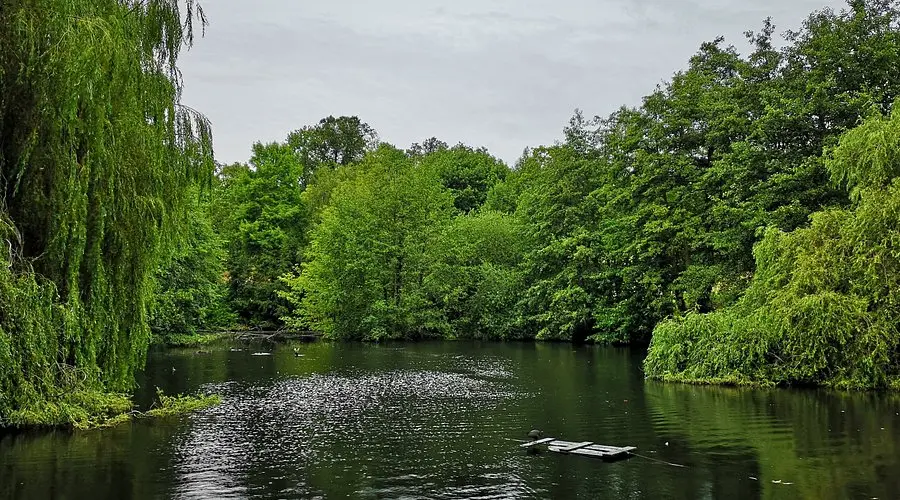
Image Source: Tripadvisor
Waterlow Park is honestly one of London’s true hidden gems, tucked away in leafy Highgate, North London. Sir Sydney Waterlow generously gifted this verdant sanctuary to Londoners as a “garden for the gardenless” way back in 1889. What a gift!
Today, this beautiful 26-acre green oasis sits on a steep hillside and rewards visitors with breathtaking city views. It’s one of those Parks in London you might not have heard of, but definitely should visit.
Waterlow Park: Hidden Gem Appeal
This park remains a wonderfully peaceful alternative to the sometimes bustling Hampstead Heath nearby, yet surprisingly few people seem to know about it!
- Its charm lies in the lovely mix of shady tree spots and natural spring waters that create quiet, reflective retreats.
- Visitors will find charming marble sundials nestled in well-laid-out gardens.
- The paths feature benches dotted with brass memorial plaques, each telling its own little story – it adds a unique touch, maybe even qualifying as one of those Unusual Free Things to Do in London.
- The park’s high position offers views that genuinely match Parliament Hill’s famous outlook. You can see The Shard piercing the horizon clearly on good days, giving some Rooftop Bars London a run for their money!
Waterlow Park: Ponds and Gorgeous Gardens
Three picturesque ponds dot the landscape, their waters flowing down from natural springs.
- These peaceful spots serve as perfect wildlife watching points – you’ll often see ducks swimming lazily across the dark green waters.
- The rich ecosystem here supports a variety of creatures: herons, woodpeckers, hedgehogs, bats, frogs, butterflies, and bees all call this place home.
- The landscape blends lovely open spaces with carefully tended terraced gardens.
- A kitchen garden and orchard got a fresh look after a detailed renovation back in 2005 and are wonderful to explore.
Waterlow Park: Welcoming Family-Friendly Vibe
Parents love this park’s recreational options. It’s a great choice among North London’s Parks in London for families.
- Two playgrounds serve different age groups: younger ones under 5 have their own enclosed space, while older kids enjoy the equipment near the lower Swains Lane entrance. Perfect for keeping the little ones happy, similar to other Fun Things to Do in London with Kids.
- Active visitors can make use of the six tennis courts.
- Since 2019, a pétanque pitch lets people enjoy a game of boules – you can bring your own set or borrow one from the Lauderdale House café nearby.
- The park’s lovely community spirit really shines through with volunteer gardening sessions held on Monday and Thursday mornings. Wildlife surveys also welcome everyone to join in and get involved.
Crystal Palace Park: Dinosaurs, Mazes, and Victorian Charm

Image Source: Crystal Palace Park Trust
Crystal Palace Park spans an incredible 200-acre landscape that beautifully combines Victorian heritage with modern recreation. This Grade II listed space, which emerged after the famous 1851 Great Exhibition moved here, gives visitors one of London’s most unique and family-friendly park experiences. It’s unlike any other of the Parks in London!
Crystal Palace Park: The Amazing Dinosaur Trail
The park’s Victorian dinosaur statues are its absolute crown jewel – and they are brilliant!
- Benjamin Waterhouse Hawkins and the renowned scientist Richard Owen created these life-size models back in 1854, making them the world’s very first artistic representations of dinosaurs! How amazing is that?
- These remarkable sculptures sit dramatically on islands in the Lower Lake, near the Penge side of the park.
- Visitors can see about 30 different sculptures including dinosaurs, amphibians, reptiles, and mammals from across the water.
- The statues show us how Victorian scientists understood prehistoric creatures. While their interpretations might seem a bit outdated now (some look quite funny!), they remain incredibly historically valuable. It’s a fantastic free activity, similar to visiting the 15 Must-Visit Free Museums in London for a dose of history.
- You can take a free audio tour through AudioTrails or use a special dinosaur trail sheet to help you find all 14 “Extraordinary Extinct™” creatures. Definitely one of the top Fun Things to Do in London with Kids!
Crystal Palace Park: Open Spaces and Attractions
But the park offers so much more than just dinosaurs!
- There’s a Victorian circular maze stretching 49 metres (160ft) in diameter – ranking among Britain’s largest. Great fun trying to find your way out!
- The children’s farm delights families with goats, sheep, pigs, and more exotic creatures like lizards and snakes.
- Sports lovers flock to the brilliant skatepark for BMX, skateboarding, and rollerblading activities.
- The National Sports Centre on site provides three swimming pools and running tracks for serious athletes.
- Beautiful lakes, landscaped gardens, and concert areas mean visitors can easily be entertained for two to four hours exploring these vast Parks in London grounds.
Crystal Palace Park: Buzzing Family Events
The park buzzes with family activities all year round.
- Children of all ages enjoy free holiday activities during the popular Summer of Play programme.
- Music concerts, outdoor cinema screenings, wildlife walks, and organised runs happen regularly.
- One of London’s biggest weekly outdoor Farmers’ Markets brings fresh local produce to the park – perfect for grabbing picnic supplies or weekend treats, maybe even better than some options near the Best Shopping in London.
- Kids love the newly renovated playgrounds and the farm park.
- Just check the timings: the park opens at 7:30 am on weekdays and 9 am on weekends, with closing times changing depending on the season.
Ravenscourt Park: Hammersmith’s Historic Haven
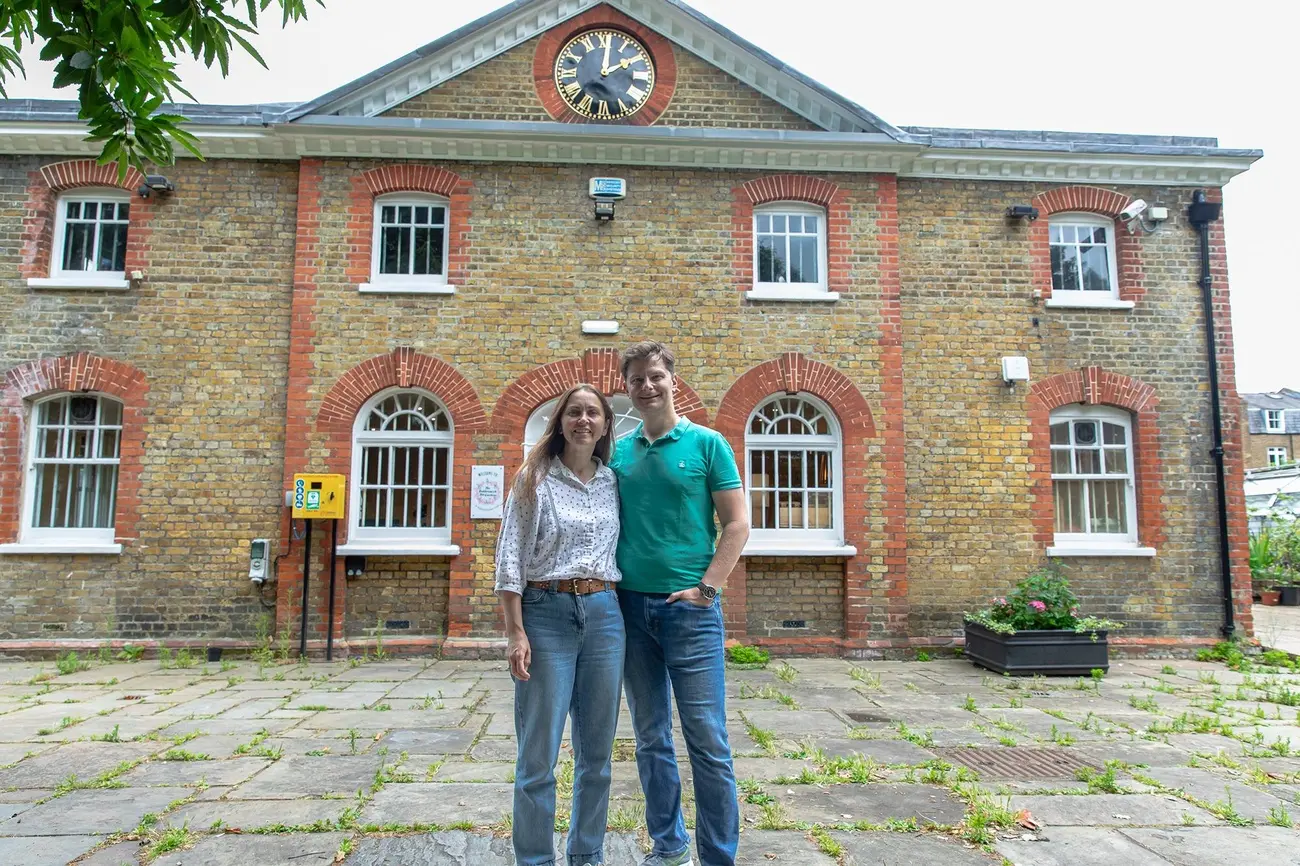
Image Source: London Borough of Hammersmith & Fulham
Ravenscourt Park sits right in the heart of Hammersmith and fascinates visitors like me with its remarkable medieval heritage stretching back to the 12th century! This 13-hectare (that’s 21 acres) green haven naturally combines its historical significance with modern recreational facilities, making it a favourite among West London’s Parks in London.
Ravenscourt Park: Excellent Playgrounds
The park’s exceptional play facilities are a huge draw for families.
- You’ll find five distinct play areas catering to different age groups – four zones are dedicated to children under 5, while one detailed playground serves the 5-13 year olds. Plenty of options for Fun Things to Do in London with Kids.
- Children can enjoy splashing about in the seasonal paddling pool or build sandcastles in the large sandpit during warmer months.
- Sports enthusiasts are well catered for too, with tennis courts, a football pitch with an astroturf surface, outdoor basketball courts, netball facilities, and a bowling green.
Ravenscourt Park: Cafe and Historic Lake
A picturesque lake fed by Stamford Brook graces the park’s centre. It’s fascinating because this is actually a remnant of the medieval moat that once protected the historic Paddenswick Manor!
- The lake’s history connects directly to “Palingswick” Manor’s medieval past as part of its protective waters – how cool is that? It feels like uncovering one of London’s little secrets, similar to these 15 Unusual Free Things to Do in London.
- The welcoming tea house, located in the charming former stable block, provides the perfect spot to unwind with a cuppa after a walk through the grounds. The park creates an ideal balance of refreshment and relaxation within its historic setting.
Ravenscourt Park: Local Charm and Community Feel
I think the park’s genuine community atmosphere really adds to its appeal.
- A wildlife garden offers a peaceful retreat for quiet contemplation.
- Local volunteers manage to keep the lovely walled garden in pristine condition – it’s great to see such community involvement.
- Residents clearly love the park’s 13-hectare space with its abundant green areas and tree-lined avenues.
- Hammersmith Tube Station provides easy access, and the park has multiple entrances on King Street, Ravenscourt Avenue, and Goldhawk Road. This makes it a perfect destination for neighbourhood residents and London visitors seeking a peaceful escape in one of the accessible Parks in London.
Putney Heath: Woodland Walks and Peaceful Escapes
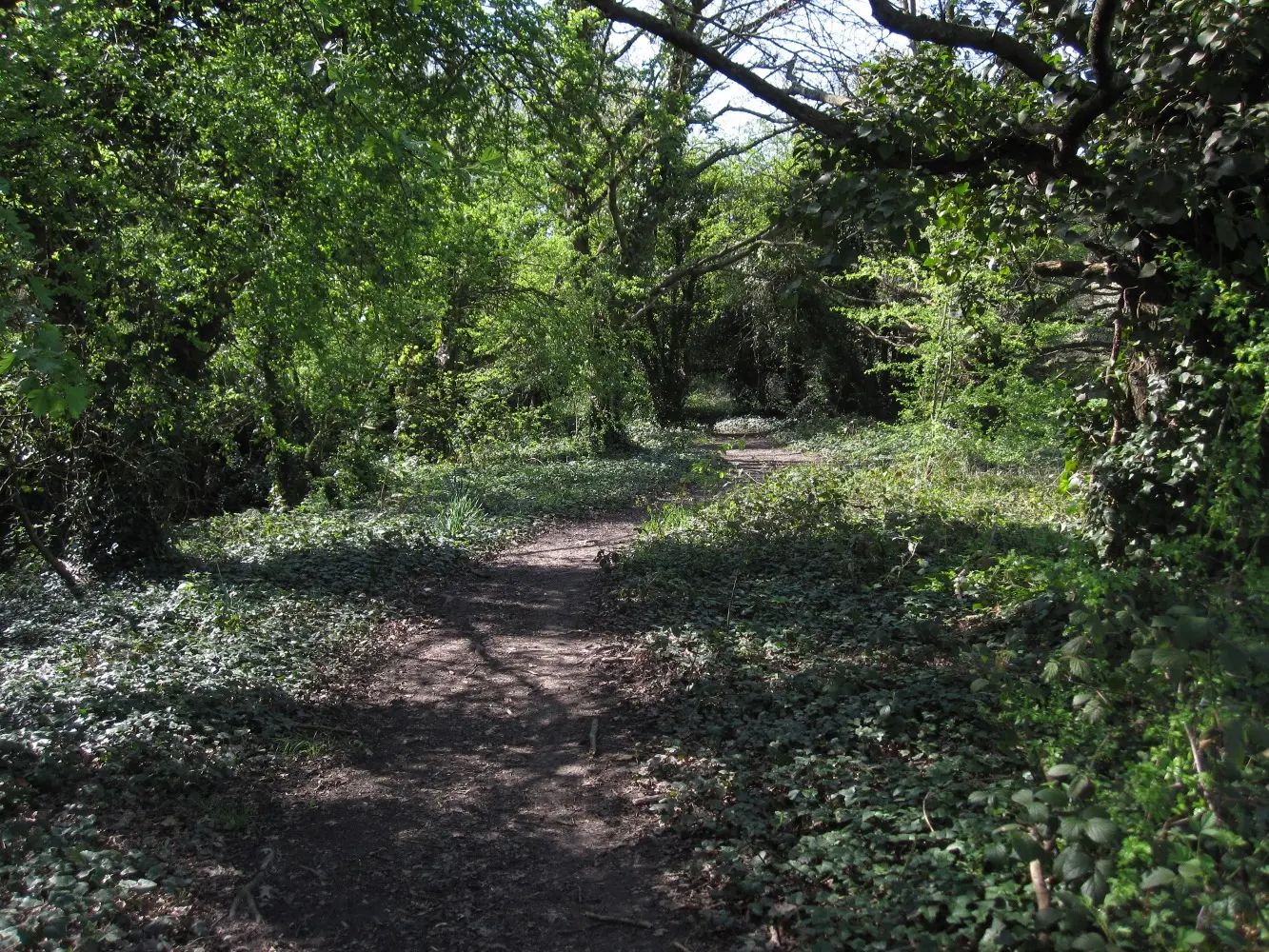
Image Source: Woodland Trust
Putney Heath stands out as one of southwest London’s cozier green spaces. If you fancy something a bit different from the grand Royal Parks in London, this is a great choice. Woodland, heathland, and open grassland blend naturally in this harmonious setting. The area remains part of a larger conservation zone that really keeps its countryside feel, despite being surprisingly close to the city centre.
Putney Heath: Wonderful Woodland Walks
The walks at Putney Heath give visitors a different experience compared to the city’s bigger, more manicured parks.
- Footpaths wind through varied landscapes featuring woodland, grassland, and heathland, creating diverse homes for wildlife.
- The trails connect naturally with Wimbledon Common, which is brilliant if you want to extend your walk into a longer adventure – maybe even feeling like one of those easy Day Trips from London without leaving the city!
- Nature lovers can tackle a 9.2-km circular route that takes you through Putney Heath, Beverley Meads, and Wimbledon Common.
- Cricket fans will love seeing the pitches on the heath – it adds a truly English touch to the scenery during summer.
Putney Heath: Wildlife Havens and Lakes
The heath plays a key role in Wandsworth’s natural network. It boasts an impressive 24 different habitats and supports some of the borough’s 4,000+ different species!
- The area features nationally important heathland nestled among its woodlands and grasslands.
- As you walk through the seasons, you might spot rabbits, foxes, and many types of birds.
- Several ponds and streams add to the heath’s natural beauty and support vital water-based ecosystems.
- These water features create homes for wildlife like frogs and various insects – keep your eyes peeled! It’s a great spot for discovering nature within the Parks in London.
Putney Heath: Peaceful Escapes from the City
Need a break during your exploration? The historic Telegraph pub sits at the heart of this quiet space, perfect for refreshments after your outdoor activities.
- Local people use the heath for running, cycling, and horse riding, enjoying the natural terrain.
- The rolling hills, thick forests, and sparkling waters help visitors and residents feel properly connected to nature.
- People looking for a genuine break from city life will find a real piece of countryside here, and it’s often not as busy as many of London’s more famous Parks in London. It’s a perfect peaceful escape.
St-Dunstan-in-the-East: Secret Garden Ruins in the City
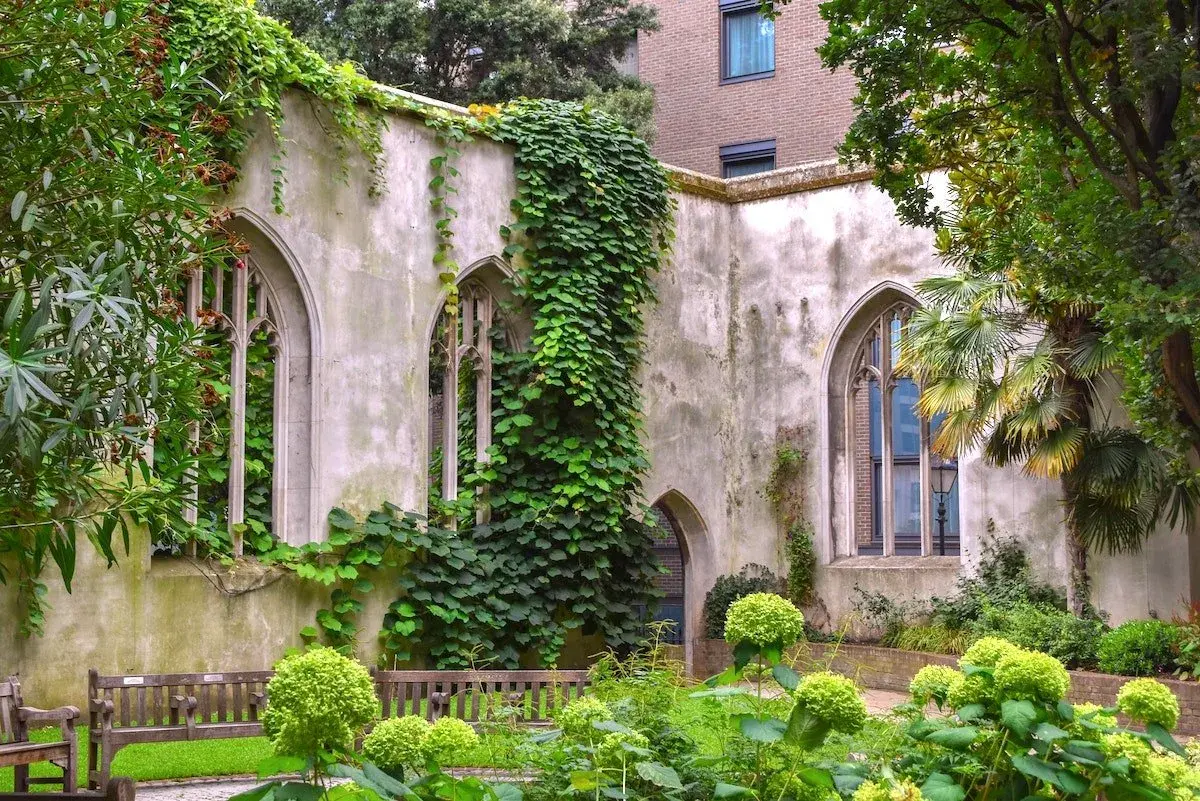
Image Source: Where Angie Wanders
You absolutely have to see this place! St-Dunstan-in-the-East really stands out from other green spaces in London. It offers this magical mix of medieval church ruins and lush botanical gardens, tucked away right in the heart of London’s busy financial district. This enchanting hidden gem nestles between modern skyscrapers, creating a striking contrast between ancient architecture and city life. It’s truly one of the most unique Parks in London.
St-Dunstan-in-the-East: Ruins and Gorgeous Gardens
Built originally way back in 1100, St-Dunstan-in-the-East has lived through almost a millennium of dramatic history.
- The Great Fire of London damaged it badly in 1666, but the incredible Sir Christopher Wren brought it back to life between 1695-1701 by adding a new tower and steeple.
- Sadly, the church faced another devastating blow during the Blitz in World War II.
- The City of London cleverly decided to turn these atmospheric ruins into a public garden in 1967, opening its gates to visitors in 1970. It’s one of my favourite 15 Unusual Free Things to Do in London.
Today, dark green ivy and rusty virginia creeper climb dramatically through stone arches where stained glass windows once sparkled.
- The remaining half walls and windows blend beautifully with plants that grow freely around them, creating what visitors often call a “bucolic botanical oasis”.
- Clever garden planning maintains a wild, almost abandoned feel, letting nature reclaim this historic structure beautifully.
St-Dunstan-in-the-East: A Quiet City Retreat
Peace just wraps around you as soon as you step inside these walls.
- The space stays eerily quiet, which is amazing considering how close it is to the Tower of London and the general city hubbub. You might find more peace here than in some larger Parks in London.
- Visitors tend to move through the majestic remains in respectful silence – it just has that atmosphere.
- This peaceful haven lets you properly escape the busy streets, especially on weekends when the surrounding office workers aren’t around.
St-Dunstan-in-the-East: Amazing Photo Opportunities
Photographers will find countless captivating shots here.
- Sunlight creates really dramatic effects as it filters through the leaves and falls on the ancient stone arches.
- You might even catch The Shard peeping through the ruined windows – perfectly capturing London’s old and new architecture together. It offers a ground-level view that rivals some snaps from Rooftop Bars London!
- The ruins look their absolute best during the golden hour, just after sunrise or before sunset, as the warm light plays beautifully on the stones.
- Top tip: Thick foliage and tall surrounding buildings can keep the garden quite dark even at midday, so if you’re a serious photographer, bringing a tripod is a good idea.
- After you’ve got your shots, take time to just sit quietly and think about all the history these incredible walls have seen. It’s quite moving.
Conclusion: Your Guide to London’s Green Heart
Wow, so there you have it! London’s parks truly serve as the green heart of this vibrant, bustling city. My journey exploring these 17 amazing green spaces has shown me just how vital they are. They offer a perfect way to find peace away from city life and showcase an incredible diversity of landscapes and attractions. From Hyde Park welcoming everyone with its massive 350 acres to the intimate, magical ruins of St-Dunstan-in-the-East, the variety within the Parks in London is simply fantastic.
These parks tell unique stories shaped over hundreds, sometimes thousands, of years. Think of Richmond Park’s magnificent deer roaming freely since 1637, or Victoria Park winning the People’s Choice Award 11 years running thanks to its brilliant community features. Families are so well catered for, with highlights like the Diana Princess of Wales Memorial Playground in Kensington Gardens or the five different play areas in Ravenscourt Park standing out as favourites in many Parks in London.
Nature lovers will definitely enjoy the amazing wildlife you can find right within London’s limits. Hampstead Heath’s ponds are home to kingfishers and dragonflies, while Greenwich Park offers those stunning city views. And how can you forget Crystal Palace Park taking you back in time with its quirky Victorian dinosaur sculptures? Such amazing discoveries await in these urban green spaces.
Of course, the popular Royal Parks in London like Hyde Park and St James’s Park absolutely deserve their fame. But I hope I’ve shown you that lesser-known spots like Putney Heath and Waterlow Park are just as rewarding and often much less crowded. London’s dedication to preserving these green spaces – covering around 35,000 acres across the city – creates an incredible network of natural havens available for everyone to enjoy.
Honestly, exploring these Parks in London has changed how I see the city. They transform beautifully with the seasons, from spring cherry blossoms lighting up Kensington Gardens to the rich red autumn leaves covering Hampstead Heath. This creates new scenery worth visiting all year round. Whether you’re seeking peaceful reflection in St-Dunstan-in-the-East, family fun in Battersea Park, a history lesson in Greenwich, or just a lovely picnic spot in Regent’s Park, London’s parks create memories that will stay with you long after you leave. Get out there and explore!
FAQs: Your Parks in London Questions Answered
Q1. Which London park is best for families with children?
A1. Oh, there are so many great options! I think Hyde Park is an excellent choice for families, offering the brilliant Diana Princess of Wales Memorial Playground, boating on the Serpentine, and various sports facilities. Kensington Gardens (right next door!) and Regent’s Park (with the Zoo) also have fantastic playgrounds and attractions that kids absolutely love. Many Parks in London cater well to families.
Q2. What is considered the most beautiful park in London?
A2. That’s tough, as beauty is definitely in the eye of the beholder! But I think many people consider Richmond Park to be one of the most stunning, with its vast open spaces, ancient trees, and those majestic roaming deer herds. Of course, Hyde Park, St. James’s Park, and Regent’s Park are also renowned for their picturesque landscapes and beautiful formal gardens. You really are spoilt for choice among the beautiful Parks in London.
Q3. Where can I experience nature within London?
A3. If you want a wilder, more natural experience, Hampstead Heath is fantastic with its swimming ponds, woodlands, and meadows. Richmond Park and Bushy Park are also excellent for spotting wildlife, especially deer. For a different kind of natural beauty, the serene Kyoto Garden in Holland Park offers a peaceful Japanese-inspired setting. These spots prove you can find proper nature escapes within the Parks in London.
Q4. Are there any unique or lesser-known parks in London worth visiting?
A4. Yes, definitely! St. Dunstan-in-the-East is a real hidden gem, featuring a public garden within the ruins of a medieval church – it’s magical. Waterlow Park in Highgate is another lovely, lesser-known spot with great views. And Crystal Palace Park, with its quirky Victorian dinosaur sculptures, offers a truly unique experience compared to the more famous Parks in London.
Q5. What activities can I enjoy in London’s parks besides walking?
A5. London’s parks offer so much more than just walking! You can swim in the lidos at London Fields or Hampstead Heath, go boating in Hyde Park, Regent’s Park or Battersea Park, visit the brilliant London Zoo in Regent’s Park, hire bikes, play tennis or other sports, explore adventure playgrounds, or even enjoy outdoor theatre and concerts in various parks during the summer months. There’s always something happening in the best Parks in London!
